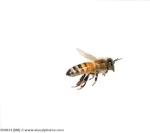Five hives in the same blueberrry meadow, same flowers, same sun, same loving care. Yet, each hive has i t’s own personality. One hive is very gentle and will let us manhandle them without a peep. Another colony is so focused on building its honey stores that they almost bump into us as they streak back to the hive. But when one hive became particularly irritable in the last week, my beekeeping partner, Betty, and I decided to take a closer look.
t’s own personality. One hive is very gentle and will let us manhandle them without a peep. Another colony is so focused on building its honey stores that they almost bump into us as they streak back to the hive. But when one hive became particularly irritable in the last week, my beekeeping partner, Betty, and I decided to take a closer look.
One sign of normal hive activity is lots of baby bees in the nursery. These future workers ensure the survival of the hive. When we opened our irritable hive, we observed that the nursery was a ghost town. The hive seemed to have lost its queen. Our suspicions were further confirmed when we noticed that in a pitiful attempt to raise a new queen, the worker bees had constructed special queen cells in the empty nursery. Ideally, hives use queen cells to prepare for the birth of a new queen when their aging queen is running out of eggs. But this hive was clearly missing its queen altogether. No wonder they were in such a bad mood.
This late in the summer, finding a new queen is not easy. Fortuntely, we know a bee supplier who happened to have one queen that had been ordered by another beekeeper and then forgotten. He was glad to dontate her to the worthy cause of keeping the hive alive.
Like most new queens, she came in a little cage, surrounded by five attendant bees, who look after her and feed her. The tiny queen cage has a small plug made of marshmallow that the bees must chew to liberate the new queen. By the time they have worked through the sweet, white plug, everyone has become used to each other’s smell and the hive is ready to accept their new monarch.

We fixed the queen’s cage in the hive by pressing it into a frame of wax and honey. Then we closed up the hive and walked away. When we checked three days later, the cage was empty and the nursery was showing signs of activity. The hive was calm once again.
Our new queen is an Italian honeybee. Italian bees were first brought from Europe to North American in the 17th century. No wonder the hive was calmer. Their queen came from an old and venerable line of sweet lovers.

